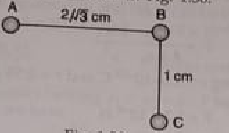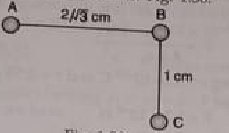EXAMPLE from MODERN PUBLICATION Chapter 4 COULOMB'S LAW for Class 12
| Class 12 | PHYSICS |
| Chapter | COULOMB'S LAW |
| MODERN PUBLICATION | EXAMPLE |
| Medium | English |
| Academic Year | 2023-2024 |
Question 12
Three point charges of +2muC ,-3muC and -3muC are kept at the vertices A, B and C respectivel of an equilaterla triangle of side 20 cm. What should be the sign and magnitude of the charge to be placed at the mid-point M of side BC, so that the charge at A remains in equilibrium?View SolutionQuestion 14
Two poit charges of charge values Q and q are placed at a distance of x and x/2 respectively from a third charge of charge value 4q, all charges being in the same striahgt line. Calculate the magnitude and nature of charge Q, such that the net force experienced by the charge q is zero.View SolutionQuestion 22
Two identical charged spheres are suspended by strings of equal lengths. The strings make an angle 30∘ with each other. When suspended in a liquid of density 800kgm−3, the angle remains the same. Wahat is the dielectric constant of the liquid? The density of the material of the sphere is 1600 kg m−3View SolutionQuestion 24
A small ball of mass 2×10−3 kg, having a charge 1 mu C, is suspended by a string of length 0.8 m. Another identical ball having the same charge is kept at the point of suspension. Determine the minimum horizontal velocity that should be imparted to the lower ball so that it can make a complete revolution.View SolutionQuestion 98
It is now believed that protons and neutrons (which constitute nuclei of ordinary matter) are themselves built out of more elementary units called quarks. A proton and a neutron consist of three quarks each. Two types of quarks, the so called ‘up’ quark (denoted by u) of charge + (2/3) e, and the ‘down’ quark (denoted by d) of charge (−1/3) e, together with electrons build up ordinary matter. (Quarks of other types have also been found which give rise to different unusual varieties of matter.) Suggest a possible quark composition of a proton and neutron.View SolutionQuestion 115
Calculate the magnitude of the electrostatic force exerted by the proton on the electron in the hydrogen atom and compare it with the weight of the electron. Given that mass of electron is 9.1×10−31 kg, charge on electron is 1.6×10−19C and radius of hydrogen atom is 0.53 ∘A.View SolutionQuestion 122
The force between two equal charges placed in a medium at a distance of 9 cm from each other is 16 dyne. On increasing one of the charges by 56 statC, it is found that the distance between the charges must be changed by 3 cm in order to keep the force between them the same Calculate the magnitude of the charges and the dielectric constant of the medium . Given :1C=3×109statC.View SolutionQuestion 123
The distance between two equal balls having unlike charges is 2cm. The radii of the balls are much less than the distance between them. The balls attract each other with a force of 36×10−5N. After the ball have been connected by a wire and latter has been removed, the balls repel each other with a force of 20.25×10−5N. Determine the original charges on the ballsView SolutionQuestion 128
Two similar small metallic spheres are suspended by eal threads from the same point. When either sphere is given a similar charge of 36 statC. The distance between them is 6 cm. If the length of each thread is 5 cm, find the mass of each sphere and the tension in each thread.View SolutionQuestion 129
Two similar small metallic spheres are suspended by eal threads from the same point. When either sphere is given a similar charge of 36 statC. The distance between them is 6 cm. If the length of each thread is 5 cm, find the mass of each sphere and the tension in each thread.View SolutionQuestion 141
A copper atom consists of copper nucleus surrounded by 29 electrons. The atomic weight of copper is 63.5mole−1. Let us now take two pieces of copper each weighing 10g. Let us trandfer one elcetron from one piece to another for every 100 atoms in that piece. What will be the Coulomb force between the two pieces after the trandfer of electrons, if they are 1cm apart? Avogadro number= 6×1023mol e−1, charge on an electron =-1.6×10−19C.View SolutionQuestion 143
A small cork ball with a mass 0.58 g is suspended from a thread 10 cm long. Another ball is fixed at a distance 10 cm from the point of suspension and at a distance of 5 cm from the thread as shown in the figure
 What shoud the magnitude of the like and equal charges on the balls be t deflect the thread through 30∘?View Solution
What shoud the magnitude of the like and equal charges on the balls be t deflect the thread through 30∘?View Solution

 Describe what happens when the sphers are slightly separated
Describe what happens when the sphers are slightly separated Describe what happens when the glass rod is subsequently removed.
Describe what happens when the glass rod is subsequently removed. Describe what happens when the spheres are separated far apart.
Describe what happens when the spheres are separated far apart. the electric force exerted by the object A on B is
the electric force exerted by the object A on B is 
 A and C are fixed in position and B can move C exerts a force of
A and C are fixed in position and B can move C exerts a force of 
 Find the magnitude and direction of the force experinced by the charge of
Find the magnitude and direction of the force experinced by the charge of